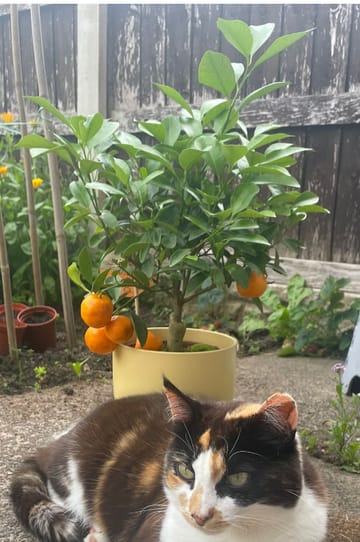Calamondin Tree
In stock


- One of the easiest citrus varieties to grow
- Tracked delivery just £6
- Price includes a pot, greetings card and gift wrapping
These are one of our most popular citrus varieties for good reason, they are one of the easiest going, have lovely scented blooms, neat foliage and produce loads of fruits even on a small tree.
Just as pictured, this weeks calamondins are covered in lots of ripening green fruits that will slowly ripen over the coming weeks and months.
Such a pretty plant that fruits on and off throughout the year. Harvesting the ripe fruits will trigger the plant to produce more flowers which smell heavenly and have the promise of the next crop to come.
Calamondin trees are the perfect windowsill citrus, they will thrive and produce fruits even in a small space. Great for citrus beginners, to brighten a kitchen or table top. The fruits are tart but delicious in a g and t, mulled wine or why not try your hand at Calamondin marmalade!
Good to know: Even though we carefully wrap all of our plants, when the fruit are heavy and or ripe on the tree, it's not unusual for the odd one to be dislodged in transit.
 4.9/ 5
230 reviews
4.9/ 5
230 reviews






Fantastic quality, healthy green leaves and can't believe the price! Very impressed and will be ordering again.

ordered for father’s day. arrived on time in good condition with fruit. very happy dad

Excellent product

Lovely plant, very healthy, lots of fruit at various stages of development. Very pleased

Plant looked good

Lovely plant

It was a beautiful plant and was even better than expected from the pictures. I loved that there was a wide selection of pots to choose from to go with it and that it was in such healthy, strong condition. The plant was delivered exactly when expected and choosing the date of this was great. I was also impressed that the plant was packaged in environmentally friendly packaging. A great quality present. I'll definitely be using this company again.

Such a beautiful little calamondin, arrived with both green and orange fruits, looking adorable, with a handwritten note. Very good packaging, survived two delivery attempts.

So perfect.

It's a Great looking plant perfect size for inside or outside urban garden

These instructions are sent with the plant gift
This little orange tree has both decorative fruit and fragrant flowers - sometimes both at once. It is a Calamondin - a cross between a kumquat and a mandarin, and is the easiest citrus tree to grow indoors. It can bring pleasure for years with the right care.
Citrus trees like lots of light and a cool but not cold room. A light room near a window or a conservatory is ideal. In winter, try and keep your tree away from central heating and in the summer protect it from strong direct sunlight. In the heat of summer you can give your plant a holiday. Put it outside on a sheltered patio and it will enjoy the fresh air. Bring it back inside when there is a nip in the evening air. Your plant will start to suffer in temperatures below 8C.
Water your tree thoroughly from the top when the top of the soil is bone dry. This will depend on the warmth of the room and could be anything from 8 days to 3-4 weeks. Always wait until the top of the soil is bone dry and the plant feels light when you pick it up before watering again. During the summer, it could be up to once a day. The roots should not be left to stand in water. A citrus feed added to the water every couple of weeks can also help to maintain a healthy plant.
These dwarf trees can grow to a maximum of two metres, producing masses of fruit every year. The fruits of this tree are very tart. However they make a refreshing and unusual addition to cold drinks, they can be used in place of other citrus in fish and game dishes and make a wonderful marmalade!
Problem Solving:
Overwatering, underwatering and shock can all be the cause of leaf drop. One or two leaves is not something to worry about but more than 10 and your plant is not happy. However, in most cases, return to a regular watering routine and temperature will lead to recovery. If the new growth on your plant is very light in colour or has a mottled look, it is likely that your plant is lacking one of the trace elements. A good citrus feed added when watering should soon colour the leaves up. In the unlikely event that you find any pests (eg. aphids or caterpillars) on your plant use a soft soap or pest spray to wash off the offending creatures and pick off any damaged leaves to keep the plant tidy.
The fruit of this tree are very tart, so don't try and eat them raw. However they make a refreshing and unusual addition to cold drinks and and add a great flavour to game and poultry dishes
More Information
Scientific Name:Citrus mitis
A hybrid of Citrus reticulata and Fortunella species
Small white flowers
Small orange edible fruit.
This is ideal for citrus beginners as it is a very undemanding citrus plant producing fruit and flowers all year round.
http://www.grouprecipes.com/8460/calamondin-marmalade.html
Originally from South East Asia. This species is known to us only as an ornamental citrus plant


















